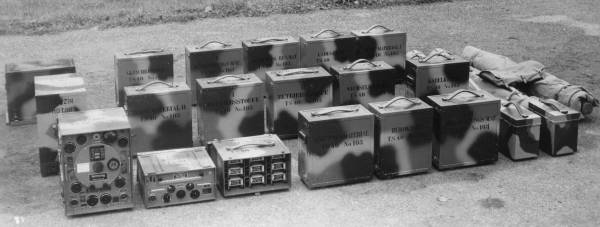Inhaltsverzeichnis
SE-215: Heavy Portable Wireless Station 40
Tragbar Schwere Funkstation 40 (Heavy portable wireless station), TS 40; developed and produced by Zellweger AG, Uster.
As a replacement of the Tragbar Schwere Funkstation 18/25 (Heavy portable wireless station 18/25) and the „Fahrbar Leichte Funkenstation 19/25“ (Light mobile wireless station 19/25), Zellweger AG, Uster developed a new wireless station covering the longwave and shortwave band in the years 1938 - 1940.
Still according to the doctrine of use from the twenties / thirties, the wireless station was designed on a single axis trailer to be pulled by another vehicle, it got the nickname „vegetables trailer“ from a kind of trailer used by vegetable farmers.
If mobile use on a trailer was impossible, in case the station should be operated in a bunker, a command post or on a hill or mountain top without an access road, the station with the same components was used as Tragbar Schwere Funkstation TS40 („Heavy portable station 1940). Nearly all accessories were included, in favour of the troop which had to carry the station, the DF antenna for the receiver and the 10 m telescopic mast was omitted.
Technische Daten
- Principle: Wireless station with separate transmitter and receiver
- Frequency range: 190 - 715 kHz, 1,5 - 4,5 MHz (Transmitter)
Power Supply
- Petrol operated or elektric motor (220 / 380 V) to drive a 50 V / 150 Hz three phase generator.
The station was powered by a petrol or by an electric motor which was coupled to a three phase generator, which provided the necessary 50 V 150 Hz voltage. A rectifier unid was used to generate the plate voltages of 1250 and 300 V for the transmitter and a solid state rectifier to generate the plate voltage of 120 V and heaters voltage of 6 V of the receiver and the accumulator charger.
An inverter is used to generate the plate voltage of the receiver E41 from the heaters accumulator power of 6 V when the generator of the transmitter was not in use or for remote control of the station.
Dimensions
- The weight of the complete station equipment is 545,5 kg.
Accessories
- Longwave antenna: Long wire antenna 50 m between two 10 m masts
- Shortwave antenna: 10 m mast antenna or 8 m long wire antenna between two 10 m masts.
Station components
Al components of the Tragbar Schwere Funkstation 40 are exchangeable and electrically identically to the components of the Fahrbar Leichte Funkstation 40 (FL40). The complete station equipment with a total weight of 545,5 kg could be carried by 23 persons (if the cable chest, a lamps set and the electric motor were omitted, 20 men were enough) or it could be mounted on six mules to be transported in mountain regions.
If mobile use was not necessary, e.g. for the installation in command posts or a fortress, the equipment could be transported on a truck - so transportation by men was a rare occasion, usually only in instruction service.
Technical principle
The main receiver E41 is a Single- / double conversion set with an IF of 70 / 465 kHz.
The transmitter S-300 is virtually identical to the one used in the „Fahrbar Leichte Funkstation“ SE-300 (FL) and has three longwave- and three shortwave frequency ranges.
Valve Layout
refer to the pages of the components
Development
As a replacement for the Tragbar Schweren Funkstation 25, Zellweger developed a portable variant (with the components in individual chests) of the Fahrbar Leichte Funkstation 40. It's components could be transported on a truck or could by carried to their position on the backs of men or mules.
Field Use
 Most of the stations have been attributed to mountain divisions; some stations were installed in fortresses.
Most of the stations have been attributed to mountain divisions; some stations were installed in fortresses.
A few other station were installed on the trucks of the military police batallions for mobile use.
In the years 1939/45, a total of 45 units of the TS 40 was acquired, they have been in use until 1969. After the introductzion of the single sideband station SE-222, the equipment underwent liquidation in 1971.

